Funny Video With Teching Explaing Putting the a on Nigga Instead of Er
by David Pilgrim, Curator, Jim Crow Museum
As for me, I raced around the dumpsters collecting discarded "White" and "Colored" signs, thinking they would be some interest to posterity in a Museum of Horrors. --Stetson Kennedy 1
I am a garbage collector, racist garbage. For three decades I have collected items that defame and belittle Africans and their American descendants. I have a parlor game, "72 Pictured Party Stunts," from the 1930s. One of the game's cards instructs players to, "Go through the motions of a colored boy eating watermelon." The card shows a dark black boy, with bulging eyes and blood red lips, eating a watermelon as large as he is. The card offends me, but I collected it and 4,000 similar items that portray blacks as Coons, Toms, Sambos, Mammies, Picaninnies, and other dehumanizing racial caricatures. I collect this garbage because I believe, and know to be true, that items of intolerance can be used to teach tolerance.
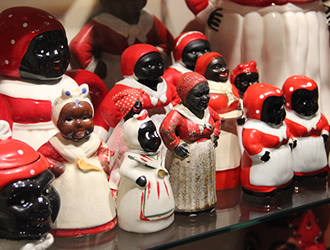
I bought my first racist object when I was 12 or 13. My memory of that event is not perfect. It was the early 1970s in Mobile, Alabama, the home of my youth. The item was small, probably a Mammy saltshaker. It must have been cheap because I never had much money. And, it must have been ugly because after I paid the dealer I threw the item to the ground, shattering it. It was not a political act; I, simply, hated it, if you can hate an object. I do not know if he scolded me, he almost certainly did. I was what folks in Mobile, blacks and whites, indelicately referred to as a "Red Nigger." In those days, in that place, he could have thrown that name at me, without incident. I do not remember what he called me, but I am certain he called me something other than David Pilgrim.
I have a 1916 magazine advertisement that shows a little black boy, softly caricatured, drinking from an ink bottle. The bottom caption reads, "Nigger Milk." I bought the print in 1988 from an antique store in LaPorte, Indiana. It was framed and offered for sale at $20. The salesclerk wrote, "Black Print," on the receipt. I told her to write, "Nigger Milk Print."

"If you are going to sell it, call it by its name," I told her. She refused. We argued. I bought the print and left. That was my last argument with a dealer or sales clerk; today, I purchase the items and leave with little conversation.
The Mammy saltshaker and the "Nigger Milk" print are not the most offensive items that I have seen. In 1874, McLoughlin Brothers of New York manufactured a puzzle game called "Chopped Up Niggers." Today, the game is a prized collectible. I have twice seen the game for sale; neither time did I have the $3,000 necessary to purchase it. There are postcards from the first half of the 20th century that show blacks being whipped, or worse, hanging dead from trees, or lying on the ground burned beyond recognition. Postcards and photographs of lynched blacks sell for around $400 each on eBay and other Internet auction houses. I can afford to buy one, but I am not ready, not yet.
My friends claim that I am obsessed with racist objects. If they are right, the obsession began while I was an undergraduate student at Jarvis Christian College, a small historically black institution in Hawkins, Texas. The teachers taught more than scientific principles and mathematical equations. I learned from them what it was like to live as a black man under Jim Crow segregation. Imagine being a college professor but having to wear a chauffeur's hat while driving your new car through small towns, lest some disgruntled white man beat you for being "uppity." The stories I heard were not angry ones; no, worse, they were matter-of-fact accounts of everyday life in a land where every black person was considered inferior to every white one, a time when "social equality" was a profane expression, fighting words. Blacks knew their clothing sizes. Why? They were not allowed to try on clothes in department stores. If blacks and whites wore the same clothes, even for a short while, it implied social equality, and, perhaps, intimacy.
I was 10 years old when Martin Luther King, Jr. was killed; we watched the funeral on a small black and white television in my fifth grade class at Bessie C. Fonville Elementary. All my classmates were black; Mobile was proudly, defiantly segregated. Two years later, in search for a cheaper house, my family moved to Prichard, Alabama, a small adjoining city that was even more segregated. Less than a decade earlier, blacks had not been allowed to use the Prichard City Library -- unless they had a note from a white person. Whites owned most of the stores. Whites held all the elected offices. I was part of the class that integrated Prichard Middle School. A local television commentator called it an "invasion." Invaders? We were children. We fought adult whites on the way to school and white children at school. By the time I graduated from Mattie T. Blount High School most of the whites had left the city. When I arrived at Jarvis Christian College I was not naive about southern race relations.
My college teachers taught the usual lessons about Frederick Douglass, Sojourner Truth, Booker T. Washington, and W.E.B. Dubois. More importantly, they taught about the daily heroism of the maids, butlers, and sharecroppers who risked their jobs, and sometimes their lives, to protest Jim Crow segregation. I learned to read history critically, from the "bottom-up," not as a linear critique of so-called great men, but from the viewpoint of oppressed people. I realized the great debt that I owed to the blacks -- all but a few forgotten by history -- who suffered so that I could be educated. It was at Jarvis Christian College that I learned that a scholar could be an activist, indeed, must be. Here, I first had the idea of building a collection of racist objects. I was not sure what I would do with it.
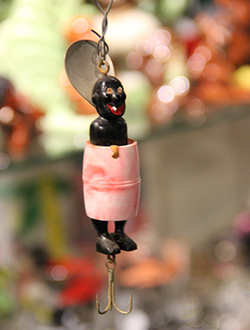
All racial groups have been caricatured in this country, but none have been caricatured as often or in as many ways as have black Americans. Blacks have been portrayed in popular culture as pitiable exotics, cannibalistic savages, hypersexual deviants, childlike buffoons, obedient servants, self-loathing victims, and menaces to society. These anti-black depictions were routinely manifested in or on material objects: ashtrays, drinking glasses, banks, games, fishing lures, detergent boxes, and other everyday items. These objects, with racist representations, both reflected and shaped attitudes towards African Americans. Robbin Henderson (Faulkner, Henderson, Fabry, & Miller, 1982), director of the Berkeley Art Center, said, "derogatory imagery enables people to absorb stereotypes; which in turn allows them to ignore and condone injustice, discrimination, segregation, and racism" (p. 11). She was right. Racist imagery is propaganda and that propaganda was used to support Jim Crow laws and customs.
Jim Crow was more than a series of "Whites Only" signs. It was a way of life that approximated a racial caste system (Woodward, 1974). Jim Crow laws and etiquette were aided by millions of material objects that portrayed blacks as laughable, detestable inferiors. The Coon caricature, for example, depicted black men as lazy, easily frightened, chronically idle, inarticulate, physically ugly idiots. This distorted representation of black men found its way onto postcards, sheet music, children's games, and many other material objects. The Coon and other stereotypical images of blacks buttressed the view that blacks were unfit to attend racially integrated schools, live in safe neighborhoods, work in responsible jobs, vote, and hold public office. With little effort I can hear the voices of my black elders -- parents, neighbors, teachers -- demanding, almost pleading, "Don't be Coon, be a man." Living under Jim Crow meant battling shame.
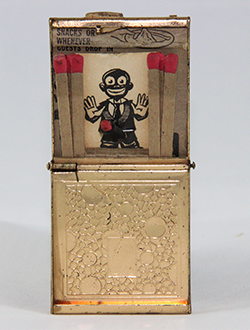
I collected many racist objects during my four years as a graduate student at The Ohio State University. Most of the items were small and inexpensive. I paid $2 for a postcard that showed a terrified black man being eaten by an alligator. I paid $5 for a matchbox that showed a Sambo-like character with oversized genitalia. The collection that I amassed was not a sample of what existed in Ohio -- or anywhere; it was, instead, a sample of what I could afford. Brutally racist items were, and remain, the most expensive "black collectibles." In Orrville, Ohio, I saw a framed print showing naked black children climbing a fence to enter a swimming hole. The caption read, "Last One In's A Nigger." I did not have the $125 to purchase it. That was the early 1980s, a few years before the prices for racist collectibles escalated. Today, that print, if authentic, sells for several thousand dollars. On vacation, I scoured flea markets and antique stores from Ohio to Alabama, looking for items that denigrated black people.
My years at The Ohio State University were, I realize now, filled with much anger. I suppose every sane black person must be angry, at least for a while. I was in the Sociology Department, a politically liberal department, and talk about improving race relations was common. There were five or six black students, and we clung together like frightened outsiders. I will not speak for my black colleagues, but I was sincerely doubtful of my white professors' understanding of everyday racism. Their lectures were often brilliant, but never complete. Race relations were fodder for theoretical debate; blacks were a "research category." Real blacks, with real ambitions and problems, were problematic. I was suspicious of my white teachers and they reciprocated.
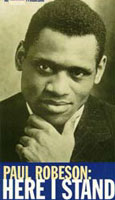
A friend suggested that I take some of my "elective courses" in the Black Studies Program. I did. James Upton, a Political Scientist, introduced me to Paul Robeson's book Here I Stand (1958). Robeson, an accomplished athlete and entertainer, was also an activist who believed that American capitalism was pernicious and detrimental to poor people, especially black Americans. Robeson maintained his political convictions despite ostracism and outright persecution. I was not anti-capitalism, but I admired his willingness to follow his political convictions -- and his unwavering fight for the rights of oppressed people. I read many books about race and race relations but few had as much impact on me as Here I Stand. I read James Baldwin's novels and essays. His anger found a willing ear, but I was troubled by his homosexuality. That is hardly surprising. I was reared in a community that was demonstratively homophobic. Homosexuality was seen as weakness, and "sissies" were "bad luck." White bigots do not have a monopoly on ignorance. Progressiveness is a journey. I had a long way to go.
I have long felt that Americans, especially whites, would rather talk about slavery than Jim Crow. All ex-slaves are dead. They do not walk among us, their presence a reminder of that unspeakably cruel system. Their children are dead. Distanced by a century and a half, the modern American sees slavery as a regrettable period when blacks worked without wages. Slavery was, of course, much worse. It was the complete domination of one people by another people -- with the expected abuses that accompany unchecked power. Slavers whipped slaves who displeased them. Clergy preached that slavery was the will of God. Scientists "proved" that blacks were less evolved, a subspecies of the human race and politicians agreed. Teachers taught young children that blacks were inherently less intelligent. Laws forbade slaves, and sometimes free blacks, from learning to read and write, possessing money, and arguing with whites. Slaves were property -- thinking, suffering property. The passing of a century and a half affords the typical American enough "psychological space" to deal with slavery; when that is not sufficient, a sanitized version of slavery is embraced.
The horrors of Jim Crow are not so easily ignored. The children of Jim Crow walk among us, and they have stories to tell. They remember Emmett Till, murdered in 1955, for an interchange with a white woman. Long before the tragic bombings of September 11, 2001, blacks who lived under Jim Crow were acquainted with terrorism. On Sunday, September 15, 1963, the Sixteenth Street Baptist Church, a black church in Birmingham, Alabama was bombed. Twenty-three people were hurt, and four girls were killed. The blacks who grew up during the Jim Crow period can tell you about this bombing -- and many others. Blacks who dared protest the indignities of Jim Crow were threatened, and when the threats did not work, subjected to violence, including bombings. The children of Jim Crow can talk about the Scottsboro boys, the Tuskegee Experiment, lynchings, and the assassination of Martin Luther King, Jr. and they have stories about the daily indignities that befell blacks who lived in towns where they were not respected or wanted.
Yes, many of us would rather talk about slavery than Jim Crow because a discussion of Jim Crow begs the question: "What about today?"
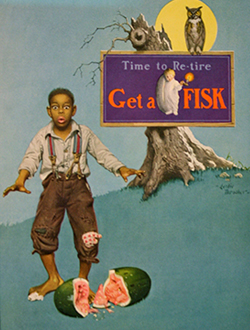
In 1990 I joined the sociology faculty at Ferris State University in Big Rapids, Michigan. It was my second teaching position and my third "real" job. At that time, my collection of racist artifacts numbered more than 1,000. I kept the collection in my home, bringing out pieces when I gave public addresses, mainly to high school students. I discovered that many young people, blacks and whites, were not only ignorant about historical expressions of racism, but they believed that I was exaggerating when I described the awfulness of Jim Crow. Their ignorance disappointed me. I showed them segregation signs, Ku Klux Klan robes, and everyday objects that portrayed blacks with ragged clothes, unkempt hair, bulging eyes, and clown-like lips -- running toward fried chicken and watermelons and running away from alligators. I talked to the students about the connection between Jim Crow laws and racist material objects. I was too heavy-handed, too driven to make them understand; I was, that is, learning to use the objects as teaching tools -- while, simultaneously, dealing with my anger.
A seminal event occurred in 1991. A colleague told me about an elderly black woman who had a large collection of black-related objects. I will call her Mrs. Haley. She was an antique dealer in a small Indiana town. I visited her and told her about my collection. She seemed unimpressed. I described how I used the racist objects to teach students about racism. Again, she was not impressed. Her store displayed a few pieces of racist memorabilia. I asked if she kept most of the "black material" at her home. She said that she kept those pieces in the back, but I could only see them if I agreed to a condition, namely, I could never "pester" her to sell me any of the objects. I agreed. She locked the front door, put the "closed" sign in the window, and motioned for me to follow her.
If I live to be 100 I will never forget the feeling that I had when I saw her collection; it was sadness, a thick, cold sadness. There were hundreds, maybe thousands, of objects, side-by-side, on shelves that reached to the ceiling. All four walls were covered with some of the most racist objects imaginable. I owned some of the objects, others I had seen in Black Memorabilia price guides, and others were so rare I have not seen them since. I was stunned. Sadness. It was as if I could hear the pieces talking, yowling. Every conceivable distortion of black people, our people, was on display. It was a chamber of horrors. She did not talk. She stared at me; I stared at the objects. One was a life-sized wooden figure of a black man, grotesquely caricatured. It was a testament to the creative energy that often lurks behind racism. On her walls was a material record of all the hurt and harm done to Africans and their American descendants. I wanted to cry. It was at that moment that I decided to create a museum.
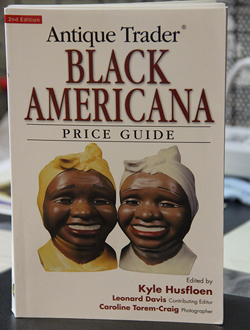
I visited her often. She liked me because I was "from down home." She told me that in the 1960s and 1970s many whites gave her racist objects. They did not want to be identified with racism. They were embarrassed. That sentiment changed in the mid-1980s. Several price guides devoted solely to racist collectibles were published. The price guides helped create the contemporary market for racist collectibles. Each new price guide showed prices escalating, and a national pursuit of racist items ensued. Mrs. Haley's collection was worth hundreds of thousands of dollars, but she had no desire to sell the pieces. They were our past, America's past. "We mustn't forget, baby," she said, without even a hint of anger. I stopped visiting after a year or so, she died, and I heard that her collection was sold to private dealers. That broke my heart on several levels. It bothers me that she did not live to see the museum she helped inspire.
I continued to collect racist objects: musical records with racist themes, fishing lures with Sambo imagery, children's games that showed naked, dirty black children -- any and every racist item that I could afford. In the cold months I bought from antique stores; in the warmer months, I traveled to flea markets. I was impatient. I sought to purchase entire collections from dealers and collectors. Again, limited finances restricted me to purchasing only small collections.
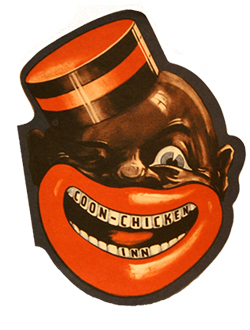
In 1994 I was part of a three-person team from Ferris State University that attended a two-week workshop at Colorado College, in Colorado Springs. The conference, sponsored by the Lilly Foundation, was devoted to the liberal arts. The charge to our team was to introduce "diversity" into the general education curriculum at Ferris State University. I traveled with Mary Murnik, a colleague, to all the local antique stores. Colorado Springs is a politically conservative city, not surprisingly, there were many racist items for sale -- some vintage, many reproductions. I bought several segregation signs, a Coon Chicken Inn glass, three racist ashtrays, and many other items. I also bought several 1920s records, all with racist themes, from a dealer who tried to talk about "the problem with colored people." I wanted the records; I did not want the conversation. John Thorp, the other member of the team, and I spent hours planning a strategy to convince the Ferris State University administration to give physical space and money to a room that would house my racist collectibles. It took several years but he and I were successful.
Today, I am the founder and curator of the Jim Crow Museum of Racist Memorabilia at Ferris State University. Most collectors are soothed by their collections; I hated mine and was relieved to get it out of my home. I donated my entire collection to the university, with the condition that the objects would be displayed and preserved. I never liked having the objects in my home. I had small children. They would wander to the basement and look at "daddy's dolls" -- two mannequins dressed in full Ku Klux Klan regalia. They played with the racist target games. One of them, I do not know which, broke a "Tom" cookie jar. I was angry for two days. The irony is not lost to me.
The museum will function as a teaching laboratory. Ferris State University faculty and students use the museum to understand historical expressions of racism. The museum also includes items created after the Jim Crow period ended; this is a valuable addition because too many students were dismissing racism as a "thing of the past." Scholars conducting research, mainly social scientists, also visit the museum. Only rarely are children allowed in the room, and adults -- preferably their parents -- are encouraged to accompany them. We encourage all visitors to watch Marlon Rigg's documentary, Ethnic Notions (Riggs, 1987) or Jim Crow's Museum (Pilgrim & Rye, 2004), a documentary I produced and Clayton Rye directed before entering the room. A trained museum facilitator is there for all tours. Clergy, civil rights groups and human rights organizations also visit the museum.
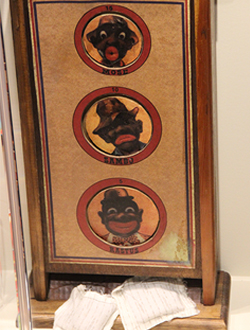
The mission of the Jim Crow Museum is straightforward: use items of intolerance to teach tolerance. We examine the historical patterns of race relations and the origins and consequences of racist depictions. The aim is to engage visitors in open and honest dialogues about this country's racial history. We are not afraid to talk about race and racism; we are afraid not to. I continue to deliver public presentations at high schools and colleges. Race relations suffer when discussions of race and racism are verboten. High schools that "sincerely" include race, racism, and diversity in their curriculums increase tolerance for others. It is relatively easy to identify those high schools that are afraid or unwilling to honestly examine race and racism. There you will find a 1950s-like pattern of everyday race relations. Racial stereotypes will dominate, though they may go unspoken. Inevitably, there will be a "racial incident," -- a racial slur hurled, a fight blamed on "the other," -- and there will be no relevant foundation laid for dealing with the problem, other than hiring me or a similar "diversity consultant" to restore order. The Jim Crow Museum is founded on the belief that open, honest, even painful discussions about race are necessary to avoid yesterday's mistakes.
Our goal is not to shock visitors. A thick naivet'e about America's past permeates this country. Many Americans understand historical racism mainly as a general abstraction: Racism existed; it was bad, though probably not as bad as blacks and other minorities claim. A confrontation with the visual evidence of racism -- especially thousands of items in a small room -- is frequently shocking, even painful. In the late 1800s traveling carnivals and amusement parks sometimes included a game called "Hit the Coon." A black man would stick his head through a hole in a painted canvas; the background was a plantation scene. White patrons would throw balls -- and in especially brutal instances, rocks -- at the black man's head to win prizes. A person living in the 21st century who sees that banner or a reproduction gets a glimpse of what it was like to be a black man in the early years of Jim Crow.
That carnival banner reinforced the idea that blacks were not as human as whites. It alleviated white guilt about black pain; it suggested that blacks did not experience pain the way normal people -- whites -- experienced pain. It helped legitimize "happy violence" directed against blacks. It functioned as an ego boost for the white hurlers. How many poorly paid, socially marginalized whites expressed their frustration at the expense of "black heads?" The "Hit the Coon" game and its cousin, "African Dodger," were eventually replaced with target games that used wooden black heads. You do not have to be a psychologist to understand the symbolic violence. Not coincidentally, games that used blacks as targets were popular when the lynching of real blacks was increasing in frequency. The Jim Crow Museum has many objects that show blacks being thrown at, hit, or beaten. We do not have the carnival banner -- but I could teach a lot with one.
Some truths are painful

Anger is a necessary leg on many journeys, but it cannot be the destination. My anger reached its apex when I read The Turner Diaries (1978), written by William L. Pierce, penname Andrew MacDonald.2 The book chronicles the "heroism" of white supremacists who overthrow the federal government, win a bloody race war, and establish a social order where whites rule. Blacks, other minorities, and the whites who support them are brutally, graphically killed. This book, arguably the most racist book produced in the second half of the 20th century, has influenced numerous racist organizations, including The Order and The Aryan Republican Army. Timothy McVeigh, convicted of the 1995 bombing of the Federal Building in Oklahoma City, was a fan of the book -- and his bombing was eerily similar to bombings described in The Turner Diaries. I made the mistake of reading it -- all 80,000 words -- in one day, while I was tired. It consumed me.
Pierce, who holds a Ph.D. in physics from the University of Colorado, bonded with Nazis in the 1960s. That explains why he wrote the book, but why did it anger me so much? I had, after all, a basement full of racist memorabilia. I was raised in the segregated South. I remember the race riots on Davis Avenue in Mobile, Alabama. I was familiar with the many ways that you can call me a nigger and threaten to hurt me. The ideas in Pierce's book, though venomous, were not new to me. Yet, that book shook me.
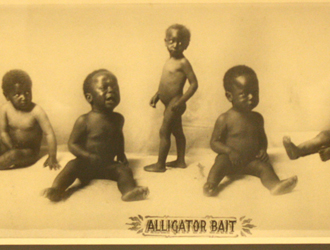
Near that time, I took a colleague's students into the Jim Crow Museum. I showed them the ugliness, the Mammy, the Sambo, the Brute, the caricatured sores foisted on black Americans. I showed them. Showed it all. And we went deep, deeper than ever before, deeper than I meant to go. My anger showed. After three hours they left, all but two -- a young black woman and a middle-aged white man. The woman sat, paralyzed, transfixed, and stunned before a picture of four naked black children. The children sat on a riverbank. At the bottom of the picture were these words: "Alligator Bait." She sat there, watching it, trying to understand the hand that had made it, the mind that conceived it. She did not say a word, but her eyes, her frown, the hand at her forehead all said, "Why, sweet Jesus, why?" The white man stopped staring at the items and stared at me. He was crying. Not a sob, a single tear stream. His tears moved me. I walked toward him. Before I could talk, he said, "I am sorry, Mr. Pilgrim. Please forgive me."
He had not created the racist objects in the room, but he had benefited from living in a society where blacks were oppressed. Racial healing follows sincere contrition. I never realized how much I needed to hear some white person, any sincere white person, say, "I am sorry, forgive me." I wanted and needed an apology -- a heartfelt one that changes two lives. His words took the steam out of my anger. The Jim Crow Museum was not created to shock, shame, or anger, but to lead to a deeper understanding of the historical racial divide. Some visitors to the museum say that I seemed so detached; I am not, I have struggled to harness my anger and channel it into productive work.
Most people who visit the Jim Crow Museum understand our mission, accept our methods, and continue the journey toward understanding and improving race relations. But we have critics. That is to be expected. The 21st century has brought a fear and unwillingness to look at racism in a deep, systematic manner. The hedonistic desire to avoid pain (or anything uncomfortable) is counter to our method of directly confronting the ugly legacy of racism. Moreover, there is a growing desire among many Americans to forget the past and move forward. "If we just stop talking about historical racism, racism will go away." It is not that easy. We may not talk openly about race, but that is not the same as forgetting it. America remains a nation residentially segregated by race. Our churches, temples, and synagogues are, in the main, racially divided. Old patterns of racial segregation have returned to many public schools. Race matters. Racial stereotypes, sometimes yelled, sometimes whispered, are common. Overt racism has morphed into institutional racism, symbolic racism, and everyday racialism. Attitudes and beliefs about race inform many of our decisions, big and small. "Let's stop talking about it," is a plea for comfort -- a comfort denied to blacks and other minorities. The way to move forward is to confront the historical and the contemporary expressions of racism, and to do so in a setting where attitudes, values, and behaviors are critiqued.
Several visitors to the museum have asked, "Why don't you have any positive items in here?" My answer is simple: we are, in effect, a black holocaust museum. I mean no disrespect to the millions of Jews and others who died at the hands of the maniacal Adolf Hitler and his followers. I hesitate to use the word "holocaust" to describe the experiences of Africans and their American descendants because I do not want to trivialize the suffering of Jews -- nor do I want to compare victimizations. But what word should I use? Thousands of Africans died during the Trans-Atlantic slave voyage. Many more lived under the brutal system of slavery, and even after slavery was officially ended thousands of blacks were lynched -- many ritualistically, by white mobs. We have today many small "white towns" that were created because the blacks were "driven out," victims of wanton racial violence.

When the Jim Crow Museum moves into a larger facility three additional "stories" will be told. Artifacts and signage will introduce visitors to the wonderful accomplishments of black scholars, scientists, artists, and inventors who thrived despite living under Jim Crow. Also, a "Civil Rights Movement" section will be added. There, visitors will find images of protestors, with signs saying, "I, Too, Am A Man." Visitors will learn about civil rights workers, many of whom are not found in history books. This section can be conceptualized as a "Death of Jim Crow" period, though vestiges of Jim Crow era thinking remain. Finally, there will be a room of reflection. I envision a mural of civil rights martyrs, from all races, surrounding visitors as they ask the important question, "What can I do today to address racism?" These will be positive sections. We also plan to enlarge photographs of blacks being "regular" people: eating, walking, studying or simply living. These poster-sized images will be placed near the caricatured objects so that visitors remember that the thousands of objects that denigrate blacks are distortions, mean-spirited exaggerations -- they are not realistic depictions. There will be several kiosks with stories from people who lived under Jim Crow.
Jim Crow was wounded in the 1950s and 1960s. The Supreme Court decision, Brown v. Board of Education of Topeka (1954) ruled segregated schools unconstitutional. This hastened the end of legal segregation, but it did not end it, as evidenced by the need for the Civil Rights Movement. Whites, especially northerners, were confronted with images of black protestors being beaten by police officers, attacked by police dogs, and arrested for trying to vote, eat at segregated lunch counters, and attend "white" schools. The 1964 Civil Rights Act, passed after (and maybe because of) President John F. Kennedy's death, was certainly a blow to Jim Crow.

One by one segregation laws were removed in the 1960s and 1970s. The elimination of legal barriers to voting led to the election of black politicians in many cities, including former bastions of segregation such as Birmingham and Atlanta. From this period forward, white colleges and universities in the South admitted black students, and hired black professors, albeit often a token number. Affirmative action programs forced employers in both the public and private sectors to hire blacks and other minorities. Some blacks appeared on television shows in non-stereotypical ways. Significant racial problems remained but it seemed that Jim Crow era attitudes and behaviors were destined to die. Many whites destroyed their household items that defamed black people, for example, ashtrays with smiling Sambos, "Jolly Nigger" banks, sheet music with titles like "Coon, Coon, Coon," and children' s books like Little Black Sambo.
Jim Crow attitudes did not die; and in many instances, have resurfaced. The end of the 20th century found many whites resentful of the "gains" by blacks. Affirmative Action policies were attacked as reverse discrimination against whites. The slavery-era Coon caricature of blacks as lazy, ne'er-do-wells re-emerged as a depiction of modern welfare recipients. White Americans support welfare for the "deserving poor," but strongly oppose it for persons perceived as lazy and unwilling to work. Black welfare recipients are seen as indolent parasites. The centuries-old fear of blacks, especially young black males, as brutes found new life in contemporary portrayals of blacks as thugs, gangsters, and menaces to society.
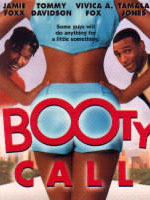
Black entertainers who capitalize financially on white America's acceptance of anti-black stereotypes perpetuate many of these images. In popular and material culture, the Mammy portrayal of black women was replaced by the Jezebel image: black women as hypersexual deviants. The racial sensitivity that had been promoted in the 1970s and 1980s was by the end of the century derided as "political correctness."
The new racial climate is marked by ambivalence and contradiction. Most polls about race show a decline in prejudice among whites. There remains a heightened sense that racism is wrong and that tolerating "racial others" is good; however, there is a growing acceptance of ideas critical of and belittling toward blacks and other minorities. Many whites are tired of talking about race, believing that America has made enough "concessions" to its black citizens. Some are rebelling against government intrusion, arguing that the government, especially the federal government, does not have the right to force integration. Still others wage personal battles against political correctness. And then there is that segment of the white population that still believes that blacks are less intelligent, less ambitious, less moral, and more given to social pathological behaviors: drug abuse, sexual deviance, and crimes against property and persons. Martin Luther King, Jr., vilified during his life, is hailed as a hero; blacks as a whole are viewed with suspicion, sometimes alarm.
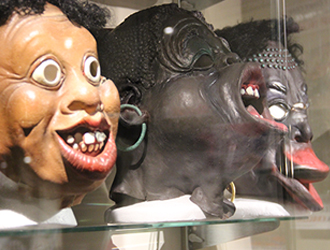
In the early 1990s I attended an academic conference in New Orleans. I searched local stores for racist objects. There were not many. Ten years later I returned to New Orleans. I found anti-black objects in many stores. This is disappointing but not surprising. Brutally racist items are readily available through Internet auction houses, most notably eBay. Indeed, practically every item housed in the Jim Crow Museum is being sold on some Internet site. Old racist items are being reproduced and new items are being created. Each year, Halloween USA produces monster masks by exaggerating the features of Africans and African Americans.
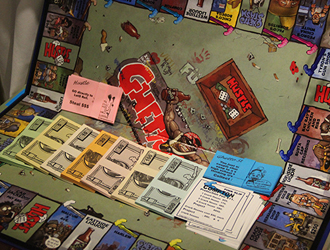
In 2003, David Chang created a national uproar with his game, Ghettopoly. Unlike Monopoly, the popular family game, Ghettopoly debases and belittles racial minorities, especially blacks. Ghettopoly has seven game pieces: Pimp, Hoe, 40 oz, Machine Gun, Marijuana Leaf, Basketball, and Crack. One of the game's cards reads, "You got yo whole neighborhood addicted to crack. Collect $50 from each playa." Monopoly has houses and hotels; Ghettopoly has crack houses and projects. The distributors advertise Ghettopoly this way: "Buying stolen properties, pimpin hoes, building crack houses and projects, paying protection fees and getting car jacked are some of the elements of the game. Not dope enough? If you don't have the money that you owe to the loan shark you might just land yourself in da Emergency Room." The game's cards depict blacks in physically caricatured ways. Hasbro, the owner of the copyright for Monopoly, has sued David Chang to make him stop distributing Ghettopoly.
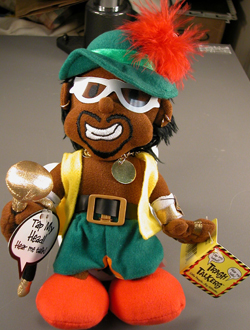
David Chang promotes his product as a satirical critique of American racism. He is not alone. AdultDolls.net is the distributor of Trash Talker Dolls, a set of dolls with stereotypical depictions of minorities. Their best seller is Pimp Daddy, a chain-wearing, gaudily dressed, black pimp who says, among other things, "You better make some money, bitch." Charles Knipp, a white man, has gained national notoriety for his minstrel-drag "Ignunce Tour." Knipp, dressed in ragged women's clothes and blackface makeup, adopts the stage persona Shirley Q. Liquor -- a Coon-like black woman with 19 children. This self-proclaimed "Queen of Dixie" has many skits -- each portraying all blacks as buffoons, whores, idlers, and crooks. Knipp's performances are popular in the Deep South; however, he has been protested in many northern cities (Boykin, 2002). Shirley Q. Liquor collectibles -- including cassette tapes, drinking glasses, and posters are popular. When satire does not work, it promotes the thing satirized. Ghettopoly, Trash Talker Dolls, and Shirley Q. Liquor skits and products portray blacks as immoral, wretched, ill-bred, cultural parasites. These modern depictions of blacks are reminiscent of the negative caricatures found more than a century ago. The satire does not work but the distributors get paid.
Understanding is the principal thing. The Jim Crow Museum's holdings force visitors to take a stand for or against the equality of all people. It works. I have witnessed deep and honest discussions about race and racism. No topics are forbidden. What role have blacks played in perpetuating anti-black caricatures and stereotypes? When, if ever, is folk art racially offensive? Is segregation along racial lines always indicative of racism? We analyze the origins and consequences of racist imagery, but we do not stop there.
I am humbled that the Jim Crow Museum has become a national resource -- and the museum's Web site, an international resource. The Web site was created by Ted Halm, the Ferris State University webmaster. Two dozen Ferris State University faculty have been trained to function as docents -- leading tours and facilitating discussions about the objects. Traveling exhibits are being conceptualized and built to carry the museum's lessons to other universities and colleges. Clayton Rye, a Ferris State University professor and filmmaker, and I created a documentary about the museum. John Thorp served the museum well as its director until his retirement, as does current director Joseph "Andy" Karafa. The museum is a team effort. A vision without help is a cathartic dream.
I see my role as decreasing. I have other goals, other garbage to collect. I have collected several hundred objects that defame and belittle women -- items that both reflected and shaped negative attitudes toward women. One day I will build a room, modeled after the Jim Crow Museum, that uses sexist objects to teach Americans to better understand sexism. That room will be called "The Sarah Baartman Room," named after a 19th century African woman brutally mistreated by her European captors. Her victimization was a "perfect" illustration of the links between racism, sexism and imperialism. There is an African proverb that says that we do not die until we are forgotten. It is my intention that Sarah Baartman never dies.
Martin Luther King, Jr. said, "Injustice anywhere is a threat to justice everywhere." In 2004, Carrie Weis, the Director of the FSU Art Gallery, and I designed and built a traveling exhibit called, "Hateful Things." This exhibit has traveled to many universities and museums teaching about the horrors of Jim Crow segregation. In 2005 we began building, "Them," a traveling exhibit that focuses on material objects that defame non-blacks, including women, Asians, Jews, Mexicans, and poor whites. Again, our goal is to use items of intolerance to teach tolerance.
I will end with a story. One of my daughters plays on an elite soccer team, meaning her practices are never done on time. One day I sat in the van with my other daughter waiting for practice to end. Nearby several white boys were clowning in front of two girls. They were all teenagers. One of the boys wore a blackfaced mask and he mocked the mannerisms of "street blacks." He turned toward us and I immediately looked at my daughter. She had lowered her head and covered her face. If you have a child then you know what I felt. If your skin is dark then you know why I do what I do.
© Dr. David Pilgrim, Professor of Sociology
Ferris State University
Feb., 2005
Edited 2012
1 Kennedy (1990, p. 234). This book, originally published in 1959, is a profound-albeit, often satirical-critique of the racial hierarchy that operated during the Jim Crow period.
2 As founder of the National Alliance, the largest neo-Nazi organization in this country, Pierce used weekly radio addresses, the Internet, white power music ventures, and racist video games to promote his vision of a whites-only homeland and a government free of "non-Aryan influence." Pierce died on July 23, 2002, his followers have vowed to carry on his work.
References
Boykin, K. (2002). Knipped in the butt: Protests close NYC drag 'minstrel' show. Retrieved from http://www.keithboykin.com/articles/shirleyq1.html.
Faulkner, J., Henderson, R., Fabry, F., & Miller, A.D. (1982). Ethnic notions: Black images In the white mind: An exhibition of racist stereotype and caricature from the collection of Janette Faulkner: September 12-November 4, 1982. Berkeley, CA: Berkeley Art Center. The images in this book inspired Marlon Riggs' documentary, Ethnic Notions.
Kennedy, S. (1959/1990). Jim Crow guide: The way it was. Boca Raton, FL: Florida Atlantic University Press.
Macdonald, A., & Nix, D. (1978). The Turner diaries. Washington, D.C.: National Alliance.
Pilgrim, D. (Producer), & Rye, C. (Director). (2004). Jim Crow's museum [Motion picture]. United States: Grim Rye Productions.
Riggs, M. (Producer/Director). (1987). Ethnic notions [Motion picture]. United States: Signifyin' Works.
Robeson, P. (1958). Here I stand. Boston, MA: Beacon Press.
Woodward, C. V. (1974). The strange career of Jim Crow (3rd rev. ed). New York, NY: Oxford University Press. This book remains a classic critique of Jim Crow laws and etiquette.
BACK TO JCM HOME
Source: https://www.ferris.edu/HTMLS/news/jimcrow/collect.htm
0 Response to "Funny Video With Teching Explaing Putting the a on Nigga Instead of Er"
Post a Comment